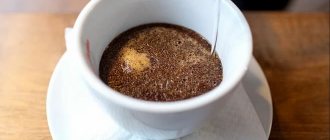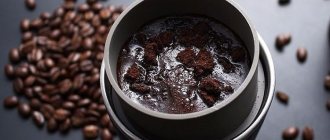Do you want to “try on” the role of a coffee taster? The preparation method used by professionals in the global coffee community to evaluate the acidity and strength of “compositions” of different varieties is also good in “Spartan” camping conditions and simply for lazy people who do not want to “pore over” the Turk. This simple brewing method reveals all facets of coffee taste and aroma.
Historical reference
In the 18th century, Europe already loved coffee, but did not have the slightest respect for the Turk. From the very beginning, gourmets tried to avoid boiling during the preparation of the drink. Even before the invention of coffee makers, there was a popular method in which ground beans were poured into a coffee pot, poured with hot water and infused. To prevent grains of grounds from getting into the drink, ground coffee was placed in a linen bag - an analogue of the current paper bag.
But in the 19th century, so many coffee makers of various designs appeared that the ancient method of brewing coffee was almost forgotten. However, professional coffee tasters, regardless of fashion trends, have always preferred to brew the drink the old fashioned way - right in the cup: this is how all the taste advantages and disadvantages of the beans are best revealed.
The fashion for brewing ground beans in a cup returned in the 90s of the 20th century, when consumers were already fed up with instant coffee, but due to lack of time they could not always use a coffee maker.
How to cook in Polish
For Polish coffee, you will need medium grind beans. Unlike the Brazilian one, it is less strong. The meal is prepared in several stages. First, half the dosage of hot water is poured into the powder and the composition is thoroughly mixed. After this, add the remaining liquid. Poles pour cardamom, cinnamon, and milk powder into a mug.
Interesting! How to choose a Turk for coffee
To brew the Warsaw version, use finely ground grains. This is an important nuance. Otherwise, you won’t get a flavorful drink because you won’t be able to strain it. Cold water is added to the powder and brought to a temperature of 80°C. Then add sugar and repeat the process. Warm baked milk is first added to the cup. Then pour in, filtering, the finished drink. The top of the treat is sprinkled with grated chocolate.
Preparing to brew coffee in a cup
All methods of brewing natural coffee in a cup are similar: ground beans are poured into a vessel, they are filled with water and infused. Depending on the method, the water can be either hot or cold. In any case, it is undesirable to use chlorinated or boiled water: it will spoil the taste of the drink.
Water for coffee should be soft: bottled, spring or well. The preferred degree of mineralization is 150 mg/l, but this is not important: the main thing is that it be in the range from 75 to 250 mg/l.
The taste of coffee depends greatly on the quality of the water.
If the recipe calls for hot water, it should be brought to the “white key” state, that is, heated until the first bubbles appear and the kettle begins to make noise. The optimal temperature is from +92 to +96 °C. The water cools down to approximately this temperature 1–2 minutes after turning off the kettle.
It is better to prepare coffee in a thick-walled cup: ceramic or earthenware. To get a portion of the drink of 80–110 ml, the volume of the cup must be at least 120–150 ml, otherwise the swollen grounds will displace the water.
Before brewing coffee in a cup, you need to warm it up by rinsing it with boiling water: then the drink will cool more slowly.
Collection of coffee berries
One of the first steps in coffee's journey into your cup is picking the coffee cherry. There are several types of it. The simplest is machine collection. Special equipment shakes the coffee trees until all the berries fall. Thus, in addition to ripe berries, unripe and overripe ones fall. After harvesting, they are sorted: knots, leaves and unsuitable berries are removed. The production of such coffee is characterized by minimal costs, but this has an extremely negative impact on the quality of the product.
A more gentle way to collect berries for coffee trees is strip picking. It is typically used in areas where machine collection is ineffective (eg mountainous areas). Its essence is to manually remove all the berries from the branch at once. Again, ripe and unripe at the same time.
The highest quality way to collect coffee berries is by hand picking, or hand picking. Pickers collect only ripe berries, and carefully leave the rest on the branches. Coffee collected this way is much tastier, even if it costs more.
Choosing the type of coffee and grinding beans
Old-school coffee lovers argue that real coffee should be made exclusively from freshly ground beans. In some ways they are right, but in practice it is difficult to use a coffee grinder in the office or at home in the morning. No problem: there are many brands of ground coffee available for sale. It is only important to seal the pack hermetically every time after preparing the drink so that the aroma does not dissipate. It is advisable to use the package of ground coffee within 2 weeks.
Typically, the ground coffee used for brewing coffee in a cup is marked accordingly. If not, it is better to choose fine or medium grind coffee. If the grains are ground too coarsely, the grains will float and will have to be caught with a spoon. Coffee ground into dust is not an acquired taste: the smallest particles form a suspension.
If you want to treat yourself to an unusual taste, you can buy ground coffee in a specialty store or in a coffee shop, where the beans are ground right before sale, at the buyer’s request.
When brewed in a cup, the taste of single-origin varieties clearly manifests itself:
- fruity shades (currant, prune) are characteristic of Ethiopian and Yemeni Arabica;
- Brazilian Arabica – soft, with moderate acidity;
- in highland South American Arabica, citrus and chocolate notes are felt;
- Kenyan and Indian Arabica (Plantation A) has a chocolate flavor.
When buying ground coffee in packs, you need to pay attention to the robusta content: it is better if there is none. Brewing in a cup takes a long time, which is why even pure Arabica coffee turns out quite strong. Robusta not only gives the drink additional strength, but also makes the taste more bitter. If an espresso blend is used to brew the cup, the Robusta content should not exceed 10–15%.
The effect of ground coffee on the human body, positive and negative aspects
An instant drink has a chemical composition that is far from a natural product, while ground coffee, which is not boiled, retains maximum natural properties that have an effect on the human body.
In addition to the caffeine itself, which is part of coffee, ground beans contain numerous natural oils and fats (lipids), organic acids, minerals and tannins, vitamins E, B and PP, as well as proteins and carbohydrates, which are beneficial for our health.
This composition has a positive effect on the body, which consists of the following points:
- increased vigor and body tone;
- dulling the feeling of hunger (therefore the drink is often used for weight loss);
- breakdown of fat cells;
- improved concentration and brain activity;
- the risk of some diseases is significantly reduced, for example, prostate cancer by 25%;
- slowing down cellular aging of the body;
- Improved mood and overall positive outlook on life due to stimulation of brain hormones.
With significant abuse of ground coffee, there may be negative consequences:
- development of insomnia;
- increased vascular pressure;
- risk of heart attack;
- migraine;
- problems with conceiving and bearing a child;
- leaching of calcium from the body;
- decreased hearing level.
We can say that the worst negative consequence is death from taking a lethal dose of caffeine, which is 10-15 grams. However, this amount of the substance is contained in 80-120 cups, so in practice it is almost impossible to die from your favorite drink, although it is clearly not worth abusing it.
For you:
Baileys coffee - exquisite “Irish” taste and unique aroma
Methods for brewing coffee in a cup
Ground coffee is measured with a spoon. One teaspoon (without a slide) contains 3 g of finely ground coffee, with a slide - 5-6 g.
There are 5 main brewing methods:
- Brazilian;
- Polish;
- Cuban;
- in the microwave;
- cold (cold brew).
Coffee brewed in a cup can be mixed with milk, syrups, and decorated with cream.
Brazilian way
This is how professional coffee tasters brew coffee. You need coarsely ground coffee (like for a French press).
Place ground coffee in a heated cup and add hot water. Approximate dosage: 8–9 g of ground beans per 100 ml of water. Infusion lasts 4–5 minutes.
During this time, large particles float to the surface, forming a “crust” that prevents the liquid from cooling. Before drinking coffee, you need to use a spoon to remove the “crust” from the cup.
Polish way
Ideal for brewing in the office. To prepare the drink, use fine or medium grind coffee. Approximate dosage: 6–7 g per 100 ml of water.
Recipe:
- Pour coffee into a heated cup.
- If you need sweet coffee, add sugar.
- You can add spices (cinnamon, cardamom) to taste.
- Splash hot water so that it just slightly covers the ground coffee.
- Stir the grounds vigorously with a spoon for 10–15 seconds.
- Pour the rest of the water into the cup and stir.
- Cover the cup with a saucer.
- Leave for 3-4 minutes.
Sugar can be added to the finished drink, but then when stirring with a spoon you will have to stir the grounds, and drinking coffee with suspension is unpleasant. The grounds moistened with water are intensively stirred so that the “blooming” occurs, a foam forms, and when infused, the grains settle to the bottom faster.
To prevent the spices from floating to the surface of the finished drink, they are mixed with dry ground coffee before water is poured into the cup.
Cuban way
It differs from Polish in only a few details:
- prepare a large portion of coffee (about 200 g), preferably in a glass glass;
- the drink must be strong, so for 100 ml of water you need 8–9 g of ground coffee;
- use cane sugar;
- If desired, add 1-2 teaspoons of rum to the finished coffee.
Brewing coffee in the microwave
The method is similar to making Turkish coffee. To obtain a drink of moderate strength, you need 6–7 g of fine or medium grind coffee per 100 ml of water. If possible, it is recommended that after preparing the coffee, pour it into a clean cup.
Recipe:
- Pour coffee into a large heatproof cup.
- Add sugar and spices if desired.
- Splash a little cold water and stir vigorously for 10–15 seconds.
- Add cold water so that its level is 3-4 cm below the edges of the cup, stir.
- Place the vessel in the microwave.
- Watch closely. As soon as the foam approaches the edges of the cup, turn off the microwave and remove the coffee.
- Cover the cup with a saucer and wait 3-4 minutes.
- Pour the coffee into a clean, warm cup.











